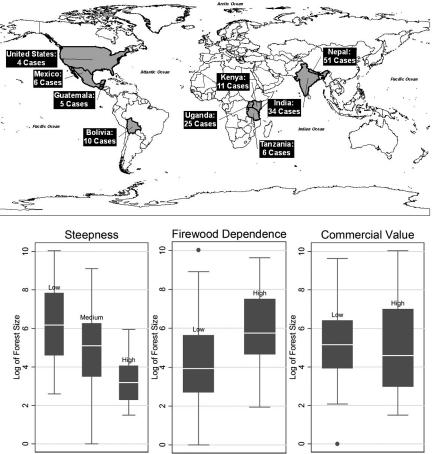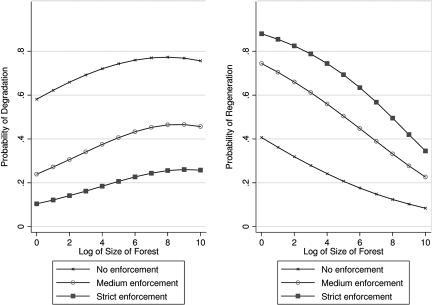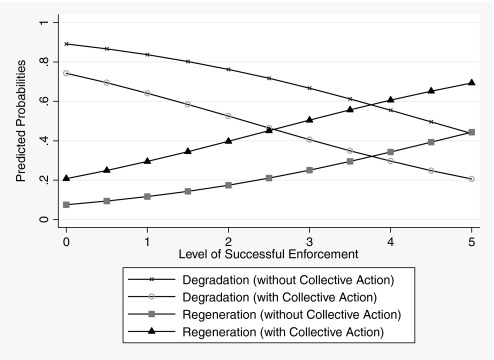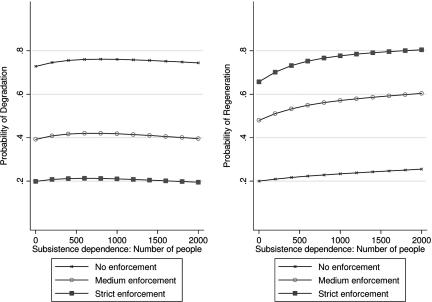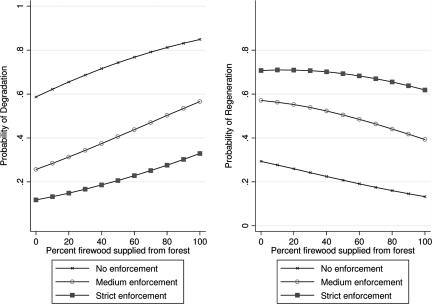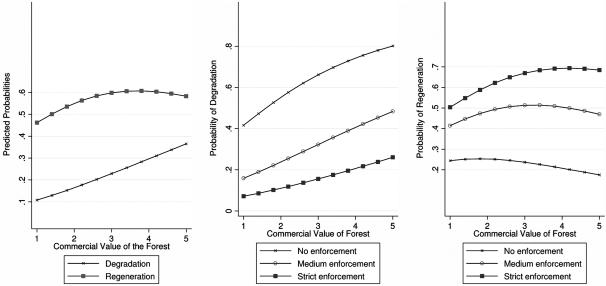Abstract
This article examines the relationship between local enforcement and forests used as commons. It uses a unique multicountry dataset, created over the past 15 years by the International Forestry Resources and Institutions Research Program. Drawing on original enforcement and forest commons data from 9 countries, we find that higher levels of local enforcement have a strong and positive but complex relationship to the probability of forest regeneration. This relationship holds even when the influence of a number of other factors such as user group size, subsistence, and commercial importance of forests, size of forest, and collective action for forest improvement activities is taken into account. Although several of the above factors have a statistically significant relationship to changes in the condition of forest commons, differences in levels of local enforcement strongly moderate their link with forest commons outcomes. The research, using data from diverse political, social, and ecological contexts, shows both the importance of enforcement to forest commons and some of the limits of forest governance through commons arrangements.
Keywords: governance, sustainability, collective action, local institutions, forest regeneration
This article investigates how local enforcement is related to changes in the condition of forest commons. Important clues to the above research question can be found in the broader literature on the commons. Indeed, in the past 2 decades, scholarly work on commons and common property has led to the formation of one of the more productive research programs in the social sciences, comprising thousands of peer-reviewed articles, research monographs, and books (1–4). Researchers have identified new substantive areas of investigation to which insights from earlier work can be applied (5). Their findings have been used in new policies related to natural resource governance in countries around the world (6, 7).
Forest commons are forests used in common by a large number of heterogeneous users. Essentially, they are forests for which the boundaries of the resource, the identity of the user group, and property rights to benefits from the resource are well defined. Users have a stake in good governance of forest commons and central governments formally or informally recognize local interests in and claims to the resource. Understanding how forest commons can be managed and governed better is important: they comprise nearly 18% of global forest area (7, 8). They make crucial contributions to livelihoods, carbon sequestration, and biodiversity conservation, in addition to many other local and global ecosystem services. Indeed, their contributions to local livelihoods far exceed their territorial extent—more than a billion people are estimated to depend at least partially on different kinds of benefits drawn from forest commons. They constitute tightly coupled social-ecological systems, characterized by reciprocal feedback loops and threshold effects (9).
Commons researchers have repeatedly highlighted the importance of collective action and institutions to successful governance of forest commons (1, 10–14). Indeed, the literature on forest commons, both through original studies and synthetic reviews, has identified several factors that are relevant to explain variations in outcomes related to sustainability of resource use and management (12, 15, 16). Recent research has also highlighted the lack of a clear relationship between the health of a forest and its ownership regime, whether it is state, private, or common property (1, 17). Even as scholars of commons recognize that a large number of different causal processes are typically at work, they focus on local enforcement as one of the more important features of sustainable forest governance (11, 18, 19).
The attention to enforcement is not misplaced (20). Forests yield multiple benefits and products: among them fodder, firewood, timber, and many non-timber products (21, 22). Multiple stakeholders advance competing claims to such benefits from forest commons (23). Scholars have pointed to the importance of coupling rules governing access to forest commons to specific social-ecological contexts (6, 24). However, without effective enforcement of such rules against those who would extract excess benefits—illegally, in excess of due allocation, and/or beyond the capacity of the resource system to supply—sustainability will remain elusive. Enforcement, and its relationship with other factors that affect changes in forest condition, is critical to sustainable governance of forest commons. Understanding enforcement is therefore an important element in advancing the frontiers of the sciences of sustainability. Building on the knowledge that forest commons are complex social-ecological systems, it is imperative that the role of enforcement be investigated in combination with other factors, taking into account the complexities of potential relationships.
In light of the importance accorded to enforcement, especially local enforcement (18, 25), our research uses a sample of 152 cases from 9 countries to study its relationship with changes in the condition of forest commons. Our analysis examines local enforcement in conjunction with 4 other factors also viewed as being central to the sustainable governance of forest commons: size of forests, collective action around forests (with a focus on improvement activities), user group size, and dependence on forests. The analysis also explores how local enforcement moderates the impact of these 4 factors.
Following the lead of studies of deforestation, much of the existing literature on forest commons assumes that given factors have a linear relationship with forest commons outcomes—whether improvements or declines in forest condition. This is however a hasty assumption. There is no reason to assume congruence in how different causal factors affect forest regeneration versus degradation. Further, it is possible for the influence of one factor on any forest outcome to vary with changes in the value of another factor. Our analytical approach allows for the possibility that a factor—for example, the degree of subsistence dependence—may have different associations with degradation and regeneration. As examined later, the analysis suggests that although larger number of users is associated with increasing probability of regeneration up to a certain point, no statistically significant relationship exists between the number of users and probability of degradation. It therefore becomes important to understand how each factor relates to changes in forest condition while taking into account other factors that affect forest outcomes.
Results
The dataset includes observations from 152 forests distributed across 9 countries (Fig. 1). Our dependent variable is “Change in Forest Condition over the Last Five Years.” It is a categorical variable denoting 3 outcomes: “Degradation” (47% of the cases), “No Change” (15%), and “Regeneration” (37%), and was derived from interviews with local users, forest guards and monitoring agents, and forestry specialists. Details on the protocols used for data collection are provided in accompanying supporting information (SI) Text. We used a discrete choice multinomial logit model to predict the outcome in every forest (n = 152; LR χ2 (20) = 115.73, Pr > χ2 = 0.0000; PseudoR2 = 0.3779). The model includes variables described in the literature as important for explaining change in forest condition (SI Text, Table S1). The model correctly predicts nearly 70% of the cases (Pearson's Test, χ2 (4) = 81.97, Pr = 0.0000, Fisher's Exact Test, Pr = 0.0000)(for details of the statistical analysis, please see Table S2 and Table S3). Using a simple mid-point threshold (Pr > = 0.5), the cases that the model is unable to predict are distributed equally across the 3 forest condition outcomes, indicating that the accuracy of model predictions is not skewed in favor of one outcome over others (Table S3).
Fig. 1.
Location and characteristics of forest commons in the sample. Representing a wide range of social–ecological contexts (Upper), the 152 forest commons also encompass variation in biophysical features (topography and size) and utility of forests (subsistence and commercial value). Sampled forest commons range from very small (< 5 ha) to very large (> 5000 ha) and are roughly equally distributed across low, medium, and highly steep slopes, low and high dependence of local users for firewood, and low and high commercial value of the forest resources (Lower).
Our analysis indicates that forests with a higher probability of regeneration are likely to be small to medium in size with low levels of subsistence dependence, low commercial value, high levels of local enforcement, and strong collective action for improving the quality of the forest. Larger forests in the sample with high subsistence dependence, low enforcement, and high commercial value have a higher probability of having degraded. While the influence of individual factors—group size, patch size, collective action, subsistence dependence, and commercial value—is as predicted, the ensuing analysis demonstrates the significant role played by the level of enforcement in moderating the influence of these factors on changes in the condition of forest commons. We present these findings below in greater detail.
Local Enforcement, Collective Action, and Changes in Forest Condition.
Probability of degradation of a forest declines monotonically with increases in the level of local enforcement; the probability of regeneration increases with levels of enforcement as expected (Fig. 2). Controlling for other factors, the size of the forest has the opposite effect—larger forests are associated with low probability of regeneration and high probability of degradation (Fig. 3). Forests with high levels of enforcement are far more likely to have regenerated compared to those with no enforcement even for large sized forests, underscoring the importance of enforcement (Fig. 3). Forests where local communities have undertaken collective action related to improvement activities (planting of saplings and clearing of debris and plant matter) are more likely to have regenerated. But more importantly, such forests respond better to increasing levels of enforcement, so that a forest with improvement activities has a more than 50% probability of regeneration at a medium level of enforcement, compared to a 25% probability for regeneration for forests without any improvement activities but the same level of enforcement (Fig. 4). Change in level of enforcement has a similar effect on the relationship between change in forest condition and improvement activities—higher levels of enforcement are associated with an increase in the probability of forest regeneration and with a lower probability of degradation.
Fig. 2.
Relationship of level of enforcement with the predicted probability that a forest has degraded or regenerated. The level of successful enforcement (x axis) varies between 0 = no enforcement and 5 = strict enforcement. Probabilities are calculated holding all other variables at their median values.
Fig. 3.
Relationship between the size of the forest commons and the predicted probabilities of degradation and regeneration. Each curve represents change in probability of degradation (Left) and regeneration (Right) with change in the log of forest size for a given level of enforcement, holding all other variables in the model at their median values.
Fig. 4.
Relationship of level of enforcement with the predicted probability that a forest has degraded or regenerated, conditional on collective action around forest commons. Each curve represents the predicted probability with or without the presence of collective action around forests, holding all other variables at their median values. The level of successful enforcement (x axis) varies between 0 = no enforcement and 5 = strict enforcement.
Local Enforcement, Forest Use/Dependence, and Changes in Forest Condition.
The absolute number of individuals using a forest for subsistence has almost no relationship with the probability of degradation and a slightly positive relationship with regeneration, after controlling for other factors (Fig. 5). Our analysis suggests that instead of the absolute number of users it may be more important to investigate the nature of demands on a forest to identify how use and dependence are related to changes in forest condition. We find that the probability of degradation increases and probability of regeneration decreases with increasing proportion of firewood needs supplied from a forest (Fig. 6). The relationship between high firewood dependence and change in forest condition is moderated, however, by the level of enforcement. Forests that supply higher levels of firewood and have high levels of enforcement have a more than 60% probability of regeneration, compared to less than 20% for forests with similar firewood dependence but no local enforcement (Fig. 6).
Fig. 5.
Relationship between the size of the user group and the predicted probabilities of degradation and regeneration. Each curve represents change in probability of degradation (Left) and regeneration (Right) with change in the group size for a given level of enforcement, holding all other variables in the model at their median values.
Fig. 6.
Relationship between subsistence dependence (measured as firewood supplied from the forest commons for household consumption) and the predicted probabilities of degradation and regeneration. Each curve represents change in probability of degradation (Left) and regeneration (Right) with change in the percent firewood supplied from the forest for a given level of enforcement, holding all other variables in the model at their median values.
The probability of degradation increases with the commercial value of forests. Local enforcement plays an important role, however. Forests with high levels of local enforcement are far less likely to be in a degraded condition compared to those without any local enforcement, even for commercially valuable forests (Fig. 7). The relationship between forest regeneration, local enforcement, and commercial value is more complex and shows distinct differences across levels of enforcement. For forests without any local enforcement, the probability of regeneration is low and declines with increase in commercial value, as expected. However, for high levels of local enforcement, the probability of regeneration increases with increases in commercial value before it starts to decrease for the highest commercial value forests in our sample (Fig. 7). Overall, commercially valuable forests have a high probability of regeneration when accompanied with high levels of enforcement.
Fig. 7.
Relationship between enforcement, commercial value, and change in forest condition. (Left) Changes in predicted probabilities of degradation and regeneration (y axis) with increases in commercial value of the forest commons (x axis), holding all other variables at their median values. (Center and Right) Moderating effect of the level of enforcement on the relationship between commercial value (x axis) and change in forest condition (y axis).
The results, when taken together, shed light on several factors associated with improvements and declines in the condition of forest commons. One of the more significant finding relates to the combinations of factors associated with different outcomes—forest degradation and regeneration. Our analytical strategy allows us to explore the extent to which the effect of a factor is moderated by another factor. The analysis confirms findings from other studies regarding the effects of factors such as forest size and dependence on forests. But it also highlights the mitigating influence of local enforcement and local collective action for forest outcomes, even in the case of large forests or those where users depend significantly on the forest for their firewood needs.
Discussion
Statistical analysis of data on forest commons from 9 countries allows us to examine the association between local enforcement and forest-related outcomes in a variety of ways: it confirms that better local enforcement is associated with a higher probability of forest regeneration. It sheds light on how 2 factors representing different aspects of collective action (forest size and improvement activities) are related to changes in forest condition at different levels of enforcement. It also shows how different types of use and extraction pressures on forests (user group size, subsistence dependence, and commercial importance of forest commons) affect the probability of regeneration or degradation of forest commons.
Although a number of earlier studies of forest commons have argued for the critical importance of local enforcement in understanding what happens to commons resources, few studies have drawn upon a large dataset from multiple countries and used this data to understand how enforcement works in conjunction with other important variables. The observed importance of local enforcement across the sampled cases is in conformity with findings of a number of earlier studies of forest and other commons. However, few existing studies are based on data collected from multiple countries using the same methods. Nor do most existing studies take into account the different factors that the literature on the commons has identified as being relevant to observed outcomes (15). Our study takes into account a subset of such factors repeatedly identified in empirical studies as being highly relevant to the condition of forest commons.
The analysis shows that higher levels of local enforcement are closely associated with increases in the predicted probability of regeneration and declines in the predicted probability of forest degradation across a variety of ecological and social contexts even when a number of other factors are taken into account. Because our analysis is based on a sample of forest commons located in multiple social and ecological contexts, it underscores the robustness of earlier research focusing on local enforcement as being key to protecting and using valuable commons resources (18, 25).
Our analysis goes further. The additional variables included in the study point to the importance of examining enforcement simultaneously with other factors. It sheds light on the specific features of user groups and forests best suited to local governance as commons. Precisely because enforcement is key to successful commons governance, our inclusion of factors related to improvement activities undertaken by users of forest commons and the size of forests used as commons become important. The presence of improvement activities in a forest commons leads to physical improvement of the forest stock—but it also indicates a user group that is able to initiate collective action and bear the costs of such action to improve the condition of its resource.
The finding that larger commons, somewhat counterintuitively, are more likely to have undergone degradation of forests (and smaller commons improvements in forest condition) again indicates the importance of institutional factors in shaping what happens in and to forests. Larger patches of forests are less easy to monitor and control. The largest forests in our sample are more than 5,000 hectares. Small groups of forest users would typically find it harder to maintain a close watch over areas this big—herein lies a lesson. The advocacy on behalf of common property arrangements needs to recognize the difficulties associated with communal governance of resources that have a significant territorial spread.
The study uncovers implications of other factors that have often been viewed as important in explaining resource condition such as user numbers and commercial importance of forests. Admittedly, a number of studies using data from specific locations have identified varying types of relationships between group size and resource condition (12, 26). Our study suggests, however, that when analysis takes into account the types of uses to which forests are put, the alleged negative relationship between absolute number of users and changes in forest condition turns out not to be important.
We also refine the ways in which existing research has treated the notion of dependence on forests. We differentiate between 2 aspects of dependence—commercial and subsistence—and find that these 2 have quite different relationships with the predicted probability of changes in forest condition. Moreover, we show that the association between probability of regeneration and commercial value of forest commons is positive for high levels of enforcement and negative for low levels. The analysis demonstrates that much of the existing literature that tries to identify a link between forest outcomes and dependence without taking into account the moderating effect of institutional factors underspecifies the relationship. It is not surprising, therefore, that different studies have found conflicting relationships between dependence and changes in the condition of commons (27, 28).
In contrast to studies at the national or global level that attribute changes in forest condition primarily to demographic and market variables, our analysis of local enforcement and forest commons draws upon and tests the inferences of a large case-study literature on the forest commons. Indeed, our study assumes importance in part because it is one of the first to extend early work on commons that examined the importance of enforcement in conjunction with a large number of other causal factors using case data on locally governed commons from multiple countries (14). Few later studies have attempted to examine either qualitative or quantitative evidence from multiple countries, while also taking into account the role of additional relevant factors. In significant part because our sampled cases span a variety of contexts in which forest commons exist, the analysis helps assess the extent to which local enforcement is a key factor in understanding forest commons outcomes and how it is related to such factors as dependence of user groups on forests, forest patch, and user group size, and collective action around the forest commons. In so doing, it identifies better the connections between local enforcement, commons outcomes, and sustainability science.
Materials and Methods
Our data were collected as part of the larger data collection effort undertaken by the International Forestry Resources and Institutions Program (IFRI) (www.umich.edu/∼ifri). The research program was founded in 1992 and currently works with 10 collaborating research centers in 9 countries as research partners. All IFRI data were collected through 10 research instruments that focus on different aspects of forests, user groups, and institutions in a given location. IFRI research protocols are shown in Fig. S1. The objective of the data collection is to identify the connections between social and ecological processes in diverse forested landscapes. Over the past decade and a half, IFRI researchers have collected data in more than 200 settlements in 10 different countries. IFRI researchers gain a common understanding of the basic concepts and data collection strategies through a research and training seminar required of researchers interested in collecting data using IFRI instruments.
The collected data have been computerized in a database that can be used to analyze a variety of forest-people-institutional relationships. The dataset used for the analysis in this article has been drawn from the larger IFRI database and covers all cases for which information is available on all of the factors included in the analysis (Table S1). The selected cases of forest commons are distributed across different forest types and topography and provide a variety of benefits to users depending on them.
Data were analyzed using STATA version 9.2. The outcome variable—Change in Forest Condition—is categorical with 3 levels, denoting “Degradation,” “No Change,” and “Regeneration.” A Generalized Linear Model was fit to the data, regressing “Change in Forest Condition” on a variety of independent variables (Table S2 and Table S3). A Generalized Ordered Logit model showed that the assumption of equal proportional odds across the 3 outcome categories was violated for several independent variables (P < 0.01 using χ2 statistic, Brant test of Parallel Regression Assumption). The model was therefore implemented using Multinomial Logit to avoid the equal proportional odds assumption, losing some efficiency in the process. However, the final model was resilient to a series of postestimation tests. Likelihood Ratio tests for independent variables (Ho: B = 0) and Wald tests for simple and composite linear hypotheses about individual parameters with a Bonferroni adjustment were not significant for any variable. The Small–Hsiao test for the assumption of Independence of Irrelevant Alternatives (IIA) was not significant (Degradation equation: χ2 = 16.37; Pr>χ2 = 0.128, Regeneration equation: χ2 = 16.84; Pr>χ2 = 0.113). Standard Errors calculated using the Huber-White Sandwich estimator did not produce significantly different results.
Graphs were produced using the SPOST suite in STATA 9.2. Model parameters were used to predict probabilities for outcomes by specifying different values for the independent variables. All other variables, except for those being displayed in the graph, were held at their median value in the sample so as to ensure that the predicted probabilities would not be affected by skewness in the distribution of any of the variables included in the model. See Dataset S1.
Supplementary Material
Acknowledgments.
Our gratitude is due to Fikret Berkes and Elinor Ostrom for their comments on an earlier draft of this paper. Rachel Kornak, Robin Humphrey, and Julie England provided valuable assistance with data cleaning. We thank all the International Forestry Resources and Institutions (IFRI) researchers and national research teams including IFRI's collaborating research centers for their contributions to the IFRI network and data over the past 15 years. We acknowledge support from the Ford Foundation and the MacArthur Foundation and National Science Foundation Grants HSD-0527138 and CNH-0709545.
Footnotes
The authors declare no conflict of interest.
This article is a PNAS Direct Submission.
See Commentary on page 13189.
This article contains supporting information online at www.pnas.org/cgi/content/full/0803399105/DCSupplemental.
References
- 1.Dietz T, Ostrom E, Stern P. The struggle to govern the commons. Science. 2003;302:1907–1912. doi: 10.1126/science.1091015. [DOI] [PubMed] [Google Scholar]
- 2.Kennedy D. In: State of the Planet 2006–2007. Kennedy D, editor. Washington, DC: Island; 2007. pp. 101–114. [Google Scholar]
- 3.National Research Council. Proceedings of the Conference on Common Property Resource Management; April 21–26, 1985; Annapolis Maryland. Washington, DC: National Academy Press; 1986. [Google Scholar]
- 4.National Research Council. Drama of the Commons. Washington, DC: National Academy Press; 2002. [Google Scholar]
- 5.Laerhoven F, Ostrom E. Traditions and trends in the study of the commons. Int J Commons. 2007;1(1):3–28. [Google Scholar]
- 6.Ostrom E. Understanding Institutional Diversity. Princeton: Princeton Univ Press; 2005. [Google Scholar]
- 7.Agrawal A. Forests, commons, and sustainability. Int J Commons. 2007;1(1):51–76. [Google Scholar]
- 8.White A, Martin A. Who Owns the World's Forests? Forest Tenure and Public Forests in Transition. Washington, DC: Forest Trends; 2002. [Google Scholar]
- 9.Liu JG, Dietz T, Carpenter SR, Alberti M, Folke C. Complexity of coupled human and natural systems. Science. 2007;317:1513–1516. doi: 10.1126/science.1144004. [DOI] [PubMed] [Google Scholar]
- 10.Agrawal A. Environmentality: Technologies of Government and the Making of Subjects. Durham, NC: Duke Univ Press; 2005. [Google Scholar]
- 11.Agrawal A, Chhatre A. Explaining success on the commons: Community forest governance in the Indian Himalaya. World Dev. 2006;34:149–166. [Google Scholar]
- 12.Baland J-M, Platteau J-P. Halting Degradation of Natural Resources: Is There a Role for Rural Communities? Oxford: Clarendon Press; 1996. [Google Scholar]
- 13.Lynch O, Talbott K. Balancing Acts: Community-Based Forest Management and National Law in Asia and the Pacific. Washington, DC: World Resources Institute; 1995. [Google Scholar]
- 14.Ostrom E. Governing the Commons: The Evolution of Institutions for Collective Action. New York: Cambridge Univ Press; 1990. [Google Scholar]
- 15.Ostrom E. A diagnostic approach for going beyond panaceas. Proc Natl Acad Sci USA. 2007;104:15181–15187. doi: 10.1073/pnas.0702288104. [DOI] [PMC free article] [PubMed] [Google Scholar]
- 16.Wade R. Village Republics: Economic Conditions for Collective Action in South India. Cambridge: Cambridge Univ Press; 1988. [Google Scholar]
- 17.Ostrom E, Nagendra H. Insights on linking forests, trees, and people from the air, on the ground, and in the laboratory. Proc Natl Acad Sci USA. 2006;103:19224–19231. doi: 10.1073/pnas.0607962103. [DOI] [PMC free article] [PubMed] [Google Scholar]
- 18.Gibson C, Ostrom E, Williams JT. Local enforcement and better forests. World Dev. 2005;33(2):273–284. [Google Scholar]
- 19.Pagdee A, Kim YS, Daugherty PJ. What makes community forest management successful: A meta-study from community forests throughout the world. Soc Nat Resour. 2006;19:33–52. [Google Scholar]
- 20.Tacconi L. Illegal Logging: Law Enforcement, Livelihoods and the Timber Trade. London: Earthscan; 2007. [Google Scholar]
- 21.Food and Agriculture Organization (FAO) Global Forest Resource Assessment, 2005: Progress Toward Sustainable Forest Management. Rome: FAO; 2006. [Google Scholar]
- 22.Steffen-Dewenter I, Kessler M, Barkmann J, Bos MM, Buchori D. Tradeoffs between income, biodiversity, and ecosystem functioning during tropical rainforest conversion and agroforestry intensification. Proc Natl Acad Sci USA. 2007;104:4973–4978. doi: 10.1073/pnas.0608409104. [DOI] [PMC free article] [PubMed] [Google Scholar]
- 23.Edwards VM, Steins NA. Developing an analytical framework for multiple-use commons. J Theor Pol. 1998;10:347–383. [Google Scholar]
- 24.McKean M. Success on the commons: A comparative examination of institutions for common property resource management. J Theor Pol. 1992;4:247–281. [Google Scholar]
- 25.Costanza R, Andrade F, Antunes P, van den Belt M, Boersma D. Principles for sustainable governance of oceans. Science. 1998;281:198–199. doi: 10.1126/science.281.5374.198. [DOI] [PubMed] [Google Scholar]
- 26.Lam WF. Governing Irrigation Systems in Nepal: Institutions, Infrastructure, and Collective Action. Oakland, CA: Institute for Contemporary Studies Press; 1994. [Google Scholar]
- 27.Fisher M. Household welfare and forest dependence in Rural Malawi. Environ Dev Econ. 2004;9:135–154. [Google Scholar]
- 28.Lise W. Factors influencing people's participation in forest management in India. Ecol Econ. 2000;34:379–392. [Google Scholar]
Associated Data
This section collects any data citations, data availability statements, or supplementary materials included in this article.



